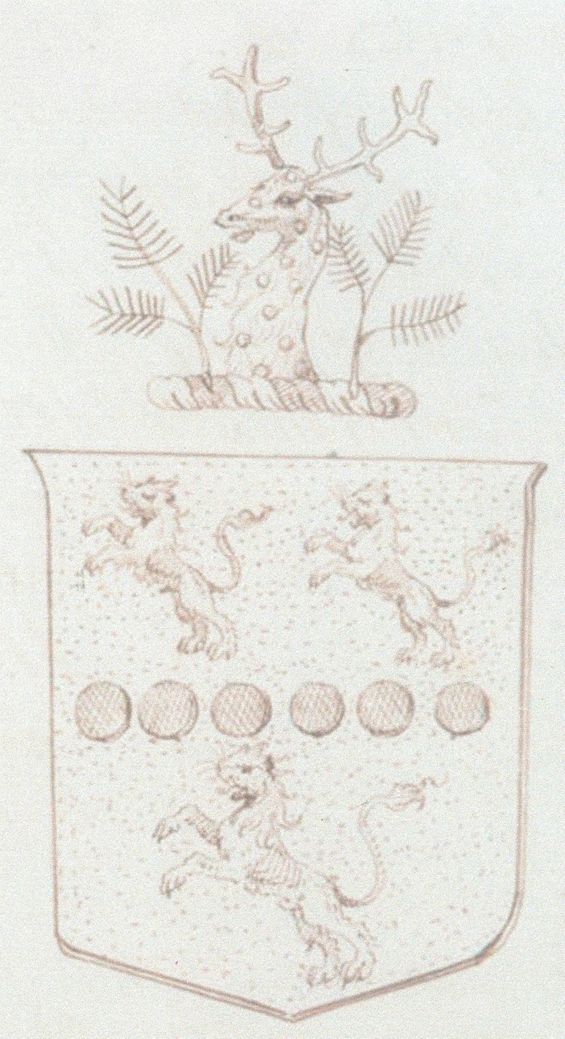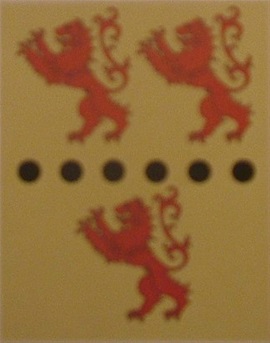The Family Heraldry
Arms (reprduced in colour below) and Crest of the Yonge Family of Puslinch
Arms and Crest
YONGE FAMILY OF PUSLINCH - ARMORIAL DETAILS
With the development of armoured knights In the middle ages, It became increasingly difficult to tell one knight from another, with armour, including a face mask, protecting the knight from head to toe. Accordingly the practice grew up of painting designs on knights shields.
With more and more knights creating their own designs it became necessary to keep a register which gave an individual an exclusive right to a particular design. The records describing the design and listing the family name are called armorials. The word "heraldry" reflects the role of a herald in tournaments or jousts who would announce each contender and describe his arms and maintain the records.
Traditions soon grew up. Certain creatures denoted particular characteristics and various inanimate objects implied certain traits, events or aspirations or reflected names or occupations.
The first arms were simple and were just a shield or escutcheon; this is still the main element, with the design set in a vertical or horizontal band. Later a helmet appeared above the shield followed often by a wreath, which symbolised the device covering the point where the crest was attached to a knight's helmet. above the helmet.
Crests, usually represented by an animal, rest on top of the shield but were not included in coats of arms until the 13th century. The crest was originally attached to a knight's helmet and served to identify him even if he lost his shield or horse.
For the Puslinch Yonge family, the work The General Armory state the arms are Or six pellets in fess sable between three lions rampant gu. With the crest is of a bucks head couped between two fern branches.
The details supplied by the College of Arms are slightly different and/or more fully described. They read:
ARMS
Or six ogresses in fess between three lions salient Gules
A copy of this appears with this article.
CREST
On a wreath Or and Gules A bucks head couped proper bezanty between two fern branches vert
The arms were granted by the College on July 2Oth 1725. Interestingly the names is spelt "Yonge" for both James Yonge (the son of Dr James) and his cousin William Young (son of Nathaniel). See article "Wha's in a Name?"
The Puslinch lion is described in General Armory as being rampant whereas the arms as described by the College of Arms and in the History of Devon quoted below, are described as being salient. The pose of the beast Is the same in each case. the only apparent difference Is that with beasts salient is that both feet are level and together as though both are on the ground.
In 1814 a grant of heraldic supporters was made to Sir William Young following his appointment to the Order of the Bath. They are:
"On the dexter side a lion Gules gorged with naval crown and charged on the shoulder with sprig of oak Or and on the sinister side a stag proper bezanty gorged as the dexter"
The family motto is "Qualis vita fInis ita" or "Qualis vita talis vita" which translates as "As is our life so is our end' or more losely "As you live so is your consequence" This is also the motto of the Coleridge family of Ottery St Mary, Devon, with whom the Yonge family is closely connected. Mottos unlike arms are not registered and can be freely adopted or changed.
A HISTORY OF DEVON published in 1797, states:
Yonge of Puslinch
This family which came from Sturminster Newton Dorset, had resided for several generations at Lansdend in the parish of Colebrooke. They removed to Puslinch in consequence of a marriage with a co heiress of Upton in the beginning of the last century.
The marriage was in fact at the start of that century. It goes on:
The late Sir William Yonge G.C.B. was of this family. He had a younger brother Admiral James Yonge of Barton End Gloucestershire. The following arms were granted in 1725 to ancestors James and William brothers of this family [actually cousins] Arms -or six ogresses in fesse between three lions salient. no tincture given Crest -On a wreath or and gules a bucks head couped between fern branches vert [In this grant of arms the name is spelt both Yonge and Young]. At this time the parties to whom the grant was made failed in proving their right to arms. But appears from documents in the Heralds College that the ancestors of the Yonges. then of Landsend in Colebrooke and Sturminster Newton had a grant from the celebrated Camden, Clarencieux King of arms of the following coats:
Arms -Per fesse sable and argent, three lions passant [N.B. not rampant) guardiant counterchanged.
Crest -A demi unicorn, argent, armed gules finned or
There are various inaccuracies in this account but what is interesting is that the work refers to the Yonge’s as failing to prove a right to bear arms. This is confirmed by the actual grant not being until 1725.
The records at the College of Arms go on that John Young, the fist Yonge we know of, had been using the arms which were later granted or devised to his grandchildren James Yonge and William Young and that they applied for formal recognition in order to regularise the position. This clearly suggests that John was on his way up in the world, probably from fairly humble origins.
The College of Arms in response to my enquiries stated
That those applying for or just using arms liked to be associated with a gentry family having existing arms and often just adopted those arms with variations
That the early 18c, the arms were granted in 1725, was a time when College was not noted for academic integrity
If asked to grant new arms the College often looked at and based arms on other families with same name without checking if they were related. They made no check of and did not require extensive pedigrees
The tree the College, have though it has some odd omissions is, the Herald said, surprisingly detailed and must have been based on some extensive evidence
Heralds did not normally require a pedigree but if an individual was clearly a gentleman and depending on time of grant if he had plenty of money, arms would be granted
That the grant to the Yonge's of Puslinch was slightly unusual in that we have a declaration as to good character of family This would perhaps be required where a family's claim was doubtful. The Declaration is from Henry Farrant of Doctors Commons and John Williams of Stowford. The Farrant’s were a Devon family and as the Doctors Commons legal system, was not concerned with heraldry matters, it seems likely that he was giving the declaration in a personal capacity. Certainly the College of Arms could see no reason why Doctors Commons should be involved. John Williams is probably from the Williams family of Stowford House, near Ivybridge, Devon, which was near to the Yonge family home of Puslinch.
That it was not necessary to be a landowner to get a grant though if the aplicant did not own land not own land, he would be unlikely to be considered a gentleman unless in one of professions such as the navy or medicine.
The essential requirement was that the claimant was a gentleman. A gentleman was someone who did not have to work with his hands for a living
Joint grants to brothers and even more so cousins were not that common but also not rare. It appears in this case that the grant was to cousins, one of whom was a Yonge and the other a Young, though in the grant the spelling “Yonge” is used for both applicants
"The General Armory is not a reliable guide, it has lots of arms which Heralds have no knowledge
That books such as "History of Devon 1797 and Lysons Magna Britannlca and Burke's Landed Gentry should not be relied upon
The lion is a very common heraldic device and no importance should be attached to fact that a number of Yonge's use it
At the time we are talking about, 18th century, the symbols chosen for arms were purely personal preference and no particular conclusions should be drawn from the actual design of arms
CONCLUSIONS
It seems clear that heraldry will not provide a breakthrough in looking for the ancestors of the Yonge family of Puslinch. However a detailed examination of arms of the family has shed new light on John Yonge, the first Yonge we know of, his status and aspirations
Because John Yonge used arms but did not have a formal grant, this suggests he did not have the money (in borderline cases, perhaps with the nouveau riche money could be an important deciding factor) and/or that he was not considered, coming within one of the anomalous occupation categories, as a gentleman.
The fact that John was a surgeon though that was not a high class profession and his brother was an officer in the Guards, suggests the family must have had some status. With John rising in the medical world in Plymouth and acquiring some property, he clearly had aspirations to be a gentleman.
The slight similarities with the arms of the Yonge's Colebrooke and Durford are not sufficiently strong on their own to support a link with either of those families. There may have been a very loose and distant link with the Yonge's of Colebrooke of Durnford, though there is no primary source evidence to support this. More likely any similarities reflect a desire to ape the arms well known county families or the College of Arms making an unwarranted assumption of a link.
It is interesting that even when the arms were granted in 1725 it was apparently necessary for the family to obtain a declaration that they were loyal subjects and would be able to maintain the position of gentlemen. They must have been considered marginal even then. In the light of the reputation of Dr James who had only died in 1721, this is surprising.
A note of caution. The arms available online for the Yonge family have nothing to do with the yonge family of Puslinch
@ R.I. Yonge 2002
Sources
College of Arms
Heraldry & the Red Lodge. Bristol Archaeological Society
The Law of Arms of England. The Heraldry Society
The General Armory
Latest comments
27.10 | 10:41
Hi Ian....Has taken me a while but finally found your website. Brillia...
20.06 | 13:06
Michael Thanks. Praise always appreciated! I presume you ar...
19.06 | 23:35
I am the Great-Great Grandson of Walter Francis Duke Young. T...
27.05 | 17:13
Thank you for this account of Charlotte M Yonge. I wouldn't say sh...

